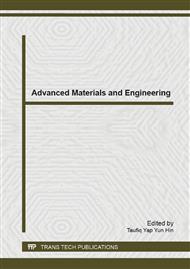p.116
p.121
p.127
p.131
p.135
p.141
p.148
p.152
p.156
Surface Modification of Titanium Alloys Using Alumina Particles Blasting for Biomedical Applications
Abstract:
Ti-based bulk metallic glass (BMG) is a new class of titanium alloys that exhibits excellent properties for biomedical applications. They have high strength, good corrosion resistance, low elastic modulus and satisfactory biocompatibility. Therefore, Ti-based BMG is an excellent alternative material to be used in biomedical application. Titanium alloy with a nominal composition of the Ti40Zr10Co36Pd14 was synthesized by replacing Cu with Co in a better-known bulk glass forming composition. Coin-shape samples with a diameter of 15 mm and thickness of 1 mm were prepared by arc-melting and casting into copper mold. The coin-shape samples were polished, then followed by blasting with 50 μm and 250 μm average particle sizes of alumina. Alumina blasting caused plastic deformation at the surface and induced change in surface roughness. The larger size of alumina particle, the higher the Ra, Rq and Rt with significant difference. Some abrasive alumina particles were found to be embedded onto the blasted surface. The blasted Ti40Zr10Co36Pd14 sample showed lower roughness values than those blasted Ti-6Al-4V samples. This may be because of the higher hardness values of Ti40Zr10Co36Pd14 sample, when compared to the softer Ti-6Al-4V samples. The contact angle measurement which demonstrated wettability of all samples did not show significant difference in a tested range of Ra (from 40 to 428 nm).
Info:
Periodical:
Pages:
135-140
Citation:
Online since:
June 2014
Keywords:
Price:
Сopyright:
© 2014 Trans Tech Publications Ltd. All Rights Reserved
Share:
Citation:


